French actress Odette Joyeux (1914-2000) was highly popular in the 1940s. She was a star in several films by Claude Autant-Lara and Marc Allégret.
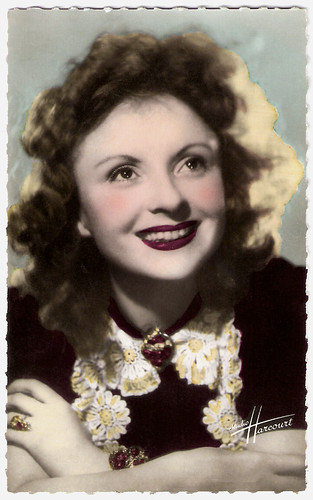
French postcard by Editions O.P., Paris, no. 46. Photo: Studio Harcourt.
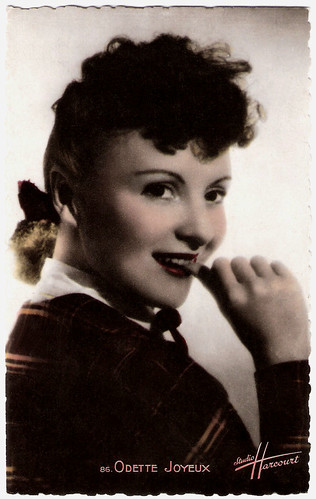
French postcard by SERP, Paris, no. 86. Photo: Studio Harcourt.
Odette Joyeux was born in Paris in 1914. She studied the school of the Ballet de l'Opéra de Paris.
She started her career in film with a bit part in Une femme a menti/A Woman has Lied (Charles de Rochefort, 1930) starring Paul Capellani.
In the same period she began her stage career under the direction of Louis Jouvet in Jean Giraudoux’ play Intermezzo (1933).
After years of small film parts and a major part in Marc Allégret’s Lac des dames/Ladies Lake (1934), her first notable film was Entrée des artistes/The Curtain Rises (Marc Allégret, 1938). She plays Cecilia, student at the Drama School run by prof. Lambertin (Louis Jouvet). She hunts for François (Claude Dauphin), her former boyfriend, who now loves Isabella (Janine Darcey). Cecilia commits suicide incriminating François, but at the end a testimony saves him.
In 1935 Odette Joyeux married actor Pierre Brasseur and became the mother of actor Claude Brasseur (1936). In 1945 she divorced Brasseur.

French postcard by Editions E.C. Paris, no. 96. Photo: Industrie Cinématographique. Publicity still for Douce/Love Story (Claude Autant-Lara, 1943).
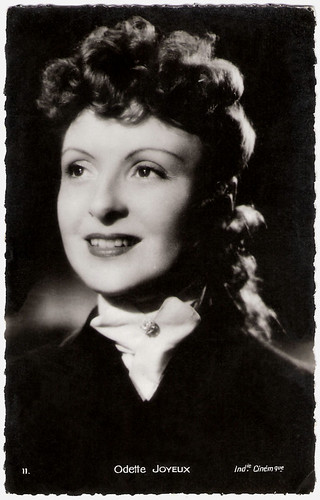
French postcard by Collection Chantal, Paris, no. 11. Photo: Industrie Cinématographique. Publicity still for Douce/Love Story (Claude Autant-Lara, 1943).
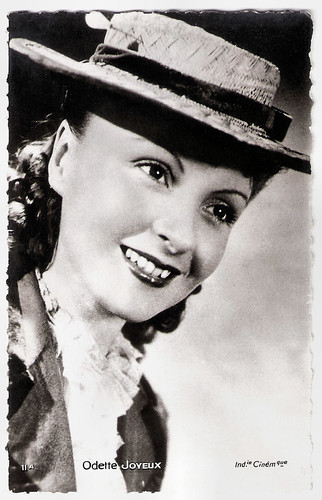
French postcard by Edit. Chantal, Rueil, no. 11A. Photo: Industrie Cinématographique. Publicity still for Douce/Love Story (Claude Autant-Lara, 1943).
During the 1940s Odette Joyeux established herself as one of France's most popular cinema actresses with such films as Le Mariage de Chiffon/Chiffon's Wedding (Claude Autant-Lara, 1942). Joyeux played an eccentric, unadapted young aristocrat, whose mother plans to remarry with a noble officer, while she herself plans to marry her uncle, a penniless aviation pioneer.
Claude Autant-Lara again cast Joyeux as the protagonist in Douce/Love Story (1943). In this period piece governess Irène (Madeleine Robinson) has an affair with director Fabien (Roger Pigaut), who is also the secret idol of Douce de Bonafé (Joyeux), Irène’s pupil. When Fabien discovers Irène wants to marry Douce’s father, an aristocratic widower, he elopes with Douce, to her immense joy. Cameraman of the film was Philippe Agostini, with whom Joyeux eventually would marry. French Wikipedia considers Douce Autant-Lara’s best film.
Joyeux played another important lead in the period piece Le baron fantôme/The Phantom Baron (Serge de Poligny, 1943), costarring Jany Holt and Alain Cuny. The film's costumes are designed by Christian Dior and the dialogues written by Jean Cocteau; the latter also played the title role.
In 1944 followed Les Petites au quai aux fleurs/The Girls From the Quai Aux Fleurs (Marc Allégret, 1944), with a script by Marcel Achard and Jean Aurenche, music by Jacques Ibert, and photography by Henri Alekan.
In 1945 Joyeux again starred in a film by Autant-Lara, scripted by Aurenche, shot by Agostini, and with costumes by Dior: Sylvie et le fantôme/Sylvia and the Phantom, released in 1946. Sylvie (Joyeux) is infatuated with the portrait of a man who killed himself for love and she believes in his ghost. Her father, a ruined baron (Pierre Larquey), arranges a man to play the ghost, but the situation becomes mixed up when three 'ghosts' turn up: the actor (Louis Salou), an escaped prisoner (François Périer), and the real ghost (Jacques Tati).
In Leçon de conduit/A Lesson How To Behave (Gilles Grangier, 1946) Joyeux plays the arrogant Micheline, abducted by Jacques (Gilbert Gil), who wants to teach her a lesson. Things run out of hand though when real gangsters abduct the bitchy girl looking for ransom.
Until the end of the 1940s, Joyeux continued to play female leading roles in French films, including Messieurs Ludovic/Three men named Ludovic (Jean-Paul Le Chanois, 1946), Pour une nuit d’amour/Passionnelle (Edmond T. Gréville, 1947), Scandale/Scandal (René Le Hénaff, 1948), and Orage d’été/Summer Storm (Jean Gehret, 1949).
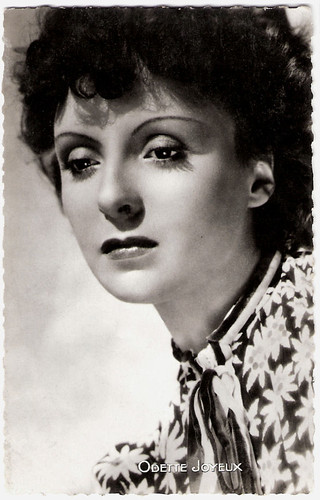
French postcard by Editions P.I., Paris, no. 1.

French postcard by Editions O.P., Paris, no. 77. Photo: Teddy Piaz, Paris.
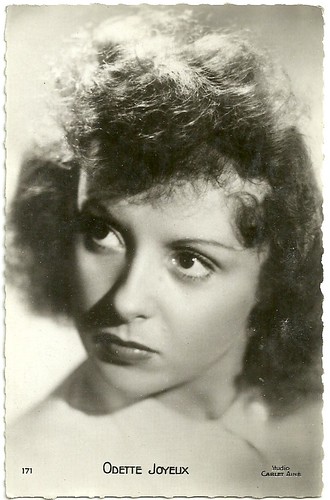
French postcard, no. 171. Photo: Studio Carlet Ainé.
From the early 1950s on, Odette Joyeux's film appearances became smaller and scarce, though she did a few television performances.
She wrote various novels, stage plays, essays on Nicéphore Niepce and on dance, and two juvenile fiction books on the ballet world she knew so well herself: L'Âge heureux (Le journal de Delphine), which was adapted for television, and Côté jardin.
In 1956 she adapted her novel La mariée est trop belle for the cinema, with Philippe Agostini as her co-scriptwriter. La mariée est trop belle/Her Bridal Night (Pierre Gaspard-Huit, 1956) starred Brigitte Bardot as a country girl who becomes a top model in Paris, and costarred Micheline Presle and Louis Jourdan.
With Philippe Agostini she also collaborated at the script for his debut as a director: Le Naïf aux quarante enfants/The Innocent with Forty Children (1957), based on the novel by Paul Guth. In 1958 Joyeux married with Agostini, with whom she lived together until her death.
In 1989 Odette Joyeux was made Chevalier de la Légion d’Honneur, and Officer in 1998, while in 1994 she was made Officer in the Orde national du Mérite. Odette Joyeux died in in 2000 in Grimaud, France, because of a brain stroke. She was 85.

Vintage postcard.
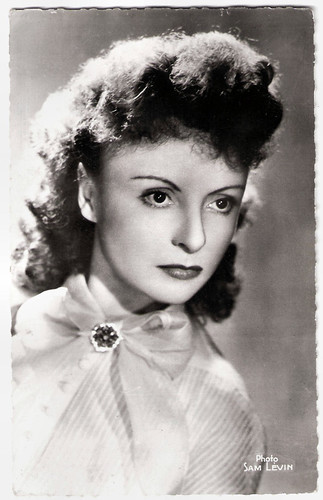
French postcard by Editions du Globe, Paris, no. 131. Photo: Sam Lévin.

French postcard by Editions P.I. Paris, no. 165. Offered by Les Carbones Korès. Photo: Sam Lévin.
Sources: Wikipedia (French, German and English), and IMDb.

French postcard by Editions O.P., Paris, no. 46. Photo: Studio Harcourt.

French postcard by SERP, Paris, no. 86. Photo: Studio Harcourt.
The Curtain Rises
Odette Joyeux was born in Paris in 1914. She studied the school of the Ballet de l'Opéra de Paris.
She started her career in film with a bit part in Une femme a menti/A Woman has Lied (Charles de Rochefort, 1930) starring Paul Capellani.
In the same period she began her stage career under the direction of Louis Jouvet in Jean Giraudoux’ play Intermezzo (1933).
After years of small film parts and a major part in Marc Allégret’s Lac des dames/Ladies Lake (1934), her first notable film was Entrée des artistes/The Curtain Rises (Marc Allégret, 1938). She plays Cecilia, student at the Drama School run by prof. Lambertin (Louis Jouvet). She hunts for François (Claude Dauphin), her former boyfriend, who now loves Isabella (Janine Darcey). Cecilia commits suicide incriminating François, but at the end a testimony saves him.
In 1935 Odette Joyeux married actor Pierre Brasseur and became the mother of actor Claude Brasseur (1936). In 1945 she divorced Brasseur.

French postcard by Editions E.C. Paris, no. 96. Photo: Industrie Cinématographique. Publicity still for Douce/Love Story (Claude Autant-Lara, 1943).

French postcard by Collection Chantal, Paris, no. 11. Photo: Industrie Cinématographique. Publicity still for Douce/Love Story (Claude Autant-Lara, 1943).

French postcard by Edit. Chantal, Rueil, no. 11A. Photo: Industrie Cinématographique. Publicity still for Douce/Love Story (Claude Autant-Lara, 1943).
Douce
During the 1940s Odette Joyeux established herself as one of France's most popular cinema actresses with such films as Le Mariage de Chiffon/Chiffon's Wedding (Claude Autant-Lara, 1942). Joyeux played an eccentric, unadapted young aristocrat, whose mother plans to remarry with a noble officer, while she herself plans to marry her uncle, a penniless aviation pioneer.
Claude Autant-Lara again cast Joyeux as the protagonist in Douce/Love Story (1943). In this period piece governess Irène (Madeleine Robinson) has an affair with director Fabien (Roger Pigaut), who is also the secret idol of Douce de Bonafé (Joyeux), Irène’s pupil. When Fabien discovers Irène wants to marry Douce’s father, an aristocratic widower, he elopes with Douce, to her immense joy. Cameraman of the film was Philippe Agostini, with whom Joyeux eventually would marry. French Wikipedia considers Douce Autant-Lara’s best film.
Joyeux played another important lead in the period piece Le baron fantôme/The Phantom Baron (Serge de Poligny, 1943), costarring Jany Holt and Alain Cuny. The film's costumes are designed by Christian Dior and the dialogues written by Jean Cocteau; the latter also played the title role.
In 1944 followed Les Petites au quai aux fleurs/The Girls From the Quai Aux Fleurs (Marc Allégret, 1944), with a script by Marcel Achard and Jean Aurenche, music by Jacques Ibert, and photography by Henri Alekan.
In 1945 Joyeux again starred in a film by Autant-Lara, scripted by Aurenche, shot by Agostini, and with costumes by Dior: Sylvie et le fantôme/Sylvia and the Phantom, released in 1946. Sylvie (Joyeux) is infatuated with the portrait of a man who killed himself for love and she believes in his ghost. Her father, a ruined baron (Pierre Larquey), arranges a man to play the ghost, but the situation becomes mixed up when three 'ghosts' turn up: the actor (Louis Salou), an escaped prisoner (François Périer), and the real ghost (Jacques Tati).
In Leçon de conduit/A Lesson How To Behave (Gilles Grangier, 1946) Joyeux plays the arrogant Micheline, abducted by Jacques (Gilbert Gil), who wants to teach her a lesson. Things run out of hand though when real gangsters abduct the bitchy girl looking for ransom.
Until the end of the 1940s, Joyeux continued to play female leading roles in French films, including Messieurs Ludovic/Three men named Ludovic (Jean-Paul Le Chanois, 1946), Pour une nuit d’amour/Passionnelle (Edmond T. Gréville, 1947), Scandale/Scandal (René Le Hénaff, 1948), and Orage d’été/Summer Storm (Jean Gehret, 1949).

French postcard by Editions P.I., Paris, no. 1.

French postcard by Editions O.P., Paris, no. 77. Photo: Teddy Piaz, Paris.

French postcard, no. 171. Photo: Studio Carlet Ainé.
Her Bridal Night
From the early 1950s on, Odette Joyeux's film appearances became smaller and scarce, though she did a few television performances.
She wrote various novels, stage plays, essays on Nicéphore Niepce and on dance, and two juvenile fiction books on the ballet world she knew so well herself: L'Âge heureux (Le journal de Delphine), which was adapted for television, and Côté jardin.
In 1956 she adapted her novel La mariée est trop belle for the cinema, with Philippe Agostini as her co-scriptwriter. La mariée est trop belle/Her Bridal Night (Pierre Gaspard-Huit, 1956) starred Brigitte Bardot as a country girl who becomes a top model in Paris, and costarred Micheline Presle and Louis Jourdan.
With Philippe Agostini she also collaborated at the script for his debut as a director: Le Naïf aux quarante enfants/The Innocent with Forty Children (1957), based on the novel by Paul Guth. In 1958 Joyeux married with Agostini, with whom she lived together until her death.
In 1989 Odette Joyeux was made Chevalier de la Légion d’Honneur, and Officer in 1998, while in 1994 she was made Officer in the Orde national du Mérite. Odette Joyeux died in in 2000 in Grimaud, France, because of a brain stroke. She was 85.

Vintage postcard.

French postcard by Editions du Globe, Paris, no. 131. Photo: Sam Lévin.

French postcard by Editions P.I. Paris, no. 165. Offered by Les Carbones Korès. Photo: Sam Lévin.
Sources: Wikipedia (French, German and English), and IMDb.
No comments:
Post a Comment